4.4 Solve Applications with Systems of Equations
Learning Objectives
By the end of this section, you will be able to:
- Translate to a system of equations
- Solve direct translation applications
- Solve geometry applications
- Solve uniform motion applications
Try It
Before you get started, take this readiness quiz:
1) The sum of twice a number and nine is [latex]31[/latex]. Find the number.
2) Twins Jon and Ron together earned [latex]$96,000[/latex] last year. Ron earned [latex]$8,000[/latex] more than three times what Jon earned. How much did each of the twins earn?
3) Alessio rides his bike [latex]3\frac{1}{2}[/latex] hours at a rate of [latex]10[/latex] miles per hour. How far did he ride?
Previously in this chapter we solved several applications with systems of linear equations. In this section, we’ll look at some specific types of applications that relate two quantities. We’ll translate the words into linear equations, decide which is the most convenient method to use, and then solve them.
We will use our Problem Solving Strategy for Systems of Linear Equations.
HOW TO
Use a problem solving strategy for systems of linear equations.
- Read the problem. Make sure all the words and ideas are understood.
- Identify what we are looking for.
- Name what we are looking for. Choose variables to represent those quantities.
- Translate into a system of equations.
- Solve the system of equations using good algebra techniques.
- Check the answer in the problem and make sure it makes sense.
- Answer the question with a complete sentence.
Translate to a System of Equations
Many of the problems we solved in earlier applications related two quantities. Here are two of the examples from the chapter on Math Models.
- The sum of two numbers is negative fourteen. One number is four less than the other. Find the numbers.
- A married couple together earns $110,000 a year. The wife earns $16,000 less than twice what her husband earns. What does the husband earn?
In that chapter, we translated each situation into one equation using only one variable. Sometimes it was a bit of a challenge figuring out how to name the two quantities, wasn’t it?
Let’s see how we can translate these two problems into a system of equations with two variables. We’ll focus on Steps 1 through 4 of our Problem Solving Strategy.
Example 4.4.1
Try It
4) Translate to a system of equations: The sum of two numbers is negative twenty-three. One number is 7 less than the other. Find the numbers.
Solution
[latex]\left\{\begin{array}{l}m+n=-23\\m=n-7\end{array}\right.[/latex]
5) Translate to a system of equations: The sum of two numbers is negative eighteen. One number is 40 more than the other. Find the numbers.
Solution
[latex]\left\{\begin{array}{l}m+n=-18\\m=n+40\end{array}\right.[/latex]
We’ll do another example where we stop after we write the system of equations.
Example 4.4.2
Translate to a system of equations:
A married couple together earns [latex]$110,000[/latex] a year. The wife earns [latex]$16,000[/latex] less than twice what her husband earns. What does the husband earn?
Solution
Step 1: We are looking for the amount that the husband and wife each earn.
Let [latex]h=[/latex] the amount the husband earns.
Let [latex]w=[/latex] the amount the wife earns.
Step 2: Translate.
A married couple together earns [latex]$110,000[/latex].
[latex]w+h=110,000[/latex]
The wife earns [latex]$16,000[/latex] less than twice what the husband earns.
[latex]w=2h-16,000[/latex]
Step 3: The system of equations is:
[latex]\left\{\begin{array}{l}w+h=110,000\\w=2h-16,000\end{array}\right.[/latex]
Try It
6) Translate to a system of equations: A couple has a total household income of $84,000. The husband earns $18,000 less than twice what the wife earns. How much does the wife earn?
Solution
[latex]\left\{\begin{array}{l}w+h=84,000\\h=2w-18,000\end{array}\right.[/latex]
7) Translate to a system of equations: A senior employee makes $5 less than twice what a new employee makes per hour. Together they make $43 per hour. How much does each employee make per hour?
Solution
[latex]\left\{\begin{array}{l}s=2n-5\\s+n=43\end{array}\right.[/latex]
Solve Direct Translation Applications
We set up but did not solve, the systems of equations in Examples 4.2.1 and 4.2.2 Now we’ll translate a situation to a system of equations and then solve it.
Example 4.4.3
Translate to a system of equations and then solve: Devon is 26 years older than his son Cooper. The sum of their ages is 50. Find their ages.
Solution
Step 1: Read the problem.
Step 2: Identify what we are looking for.
We are looking for the ages of Devon and Cooper.
Step 3: Name what we are looking for.
Let [latex]d=[/latex] Devon’s age.
Let [latex]c=[/latex] Cooper’s age
Step 4: Translate into a system of equations.
Devon is 26 years older than Cooper.
[latex]d=c+26[/latex]
The sum of their ages is 50.
[latex]d+c=50[/latex]
The system is:
[latex]\left\{\begin{array}{l}d=c+26\\d+c=50\end{array}\right.[/latex]
Step 5: Solve the system of equations.
Solve by substitution.

Substitute [latex]c + 26[/latex] into the second equation.
[latex]{\color{red}{c}}{{\color{red}{+}}}{\color{red}{26}}{+c=50}[/latex]
Solve for [latex]c[/latex].
[latex]\begin{eqnarray*}2c+26&=&50\\2c&=&24\\{\color{red}{c}}\;&=&\;{\color{red}{12}}\\\text{Substitute c = 12.}\;\;\;\;\;\;\;d&=&{\color{red}{c}}+26\\\text{Solve for d.}\;\;\;\;\;\;\;d&=&{\color{red}{12}}+26\\d&=&38\\\end{eqnarray*}[/latex]
Step 6: Check the answer in the problem.
Is Devon’s age [latex]26[/latex] more than Cooper’s?
Yes, [latex]38[/latex] is [latex]26[/latex] more than [latex]12[/latex].
Is the sum of their ages [latex]50[/latex]?
Yes, [latex]38[/latex] plus [latex]12[/latex] is [latex]50[/latex].
Step 7: Answer the question.
Devon is [latex]38[/latex] and Cooper is 12 years old.
Try It
8) Translate to a system of equations and then solve: Ali is [latex]12[/latex] years older than his youngest sister, Jameela. The sum of their ages is [latex]40[/latex]. Find their ages.
Solution
Ali is [latex]28[/latex] and Jameela is [latex]16[/latex].
9) Translate to a system of equations and then solve: Jake’s dad is [latex]6[/latex] more than [latex]3[/latex] times Jake’s age. The sum of their ages is [latex]42[/latex]. Find their ages.
Solution
Jake is [latex]9[/latex] and his dad is [latex]33[/latex].
Example 4.4.4
Translate to a system of equations and then solve:
When Jenna spent 10 minutes on the elliptical trainer and then did circuit training for 20 minutes, her fitness app says she burned 278 calories. When she spent 20 minutes on the elliptical trainer and 30 minutes circuit training she burned 473 calories. How many calories does she burn for each minute on the elliptical trainer? How many calories does she burn for each minute of circuit training?
Solution
Step 1: Read the problem.
Step 2: Identify what we are looking for.
We are looking for the number of calories burned each minute on the elliptical trainer and each minute of circuit training.
Step 3: Name what we are looking for.
Let [latex]e=[/latex] number of calories burned per minute on the elliptical trainer.
Let [latex]c=[/latex] number of calories burned per minute while circuit training.
Step 4: Translate into a system of equations.
10 minutes on the elliptical and circuit training for 20 minutes, burned 278 calories
[latex]10e+20c=278[/latex]
20 minutes on the elliptical and 30 minutes of circuit training burned 473 calories
[latex]20e+30c=473[/latex]
The system is:
[latex]\left\{\begin{array}{l}10e+20c=278\\20e+30c=473\end{array}\right.[/latex]
Step 5: Solve the system of equations.
Multiply the first equation by [latex]−2[/latex] to get opposite coefficients of [latex]e[/latex].
[latex]\left\{\begin{array}{l}{\color{red}{-}}{\color{red}{2}}(10e+20c)={\color{red}{-}}{\color{red}{2}}(278)\\20e+30c=473\end{array}\right.[/latex]
Simplify and add the equations.
Solve for [latex]c[/latex].
[latex]\begin{eqnarray*}\left\{\begin{array}{l}-20e-40c=-556\\20e+30c=473\end{array}\right.\\\hline-10c&=&-83\\c&=&8.3\end{eqnarray*}[/latex]
Substitute [latex]c = 8.3[/latex] into one of the original equations to solve for [latex]e[/latex].
[latex]\begin{eqnarray*}10e+20{\color{red}{c}}&=&278\\10e+20({\color{red}{8}}{\color{red}{.}}{\color{red}{3}})&=&278\\10e+166&=&278\\10e&=&112\\e&=&11.2\\\end{eqnarray*}[/latex]
Step 6: Check the answer in the problem.
Check the math on your own.
[latex]\left\{\begin{array}{l}10(11.2)+20(8.3)\overset?=278\\20(11.2)+30(8.3)\overset?=473\end{array}\right.[/latex]
Step 7: Answer the question.
Jenna burns 8.3 calories per minute circuit training and 11.2 calories per minute while on the elliptical trainer.
Try It
10) Translate to a system of equations and then solve: Mark went to the gym and did [latex]40[/latex] minutes of Bikram hot yoga and [latex]10[/latex] minutes of jumping jacks. He burned [latex]510[/latex] calories. The next time he went to the gym, he did [latex]30[/latex] minutes of Bikram hot yoga and [latex]20[/latex] minutes of jumping jacks burning [latex]470[/latex] calories. How many calories were burned for each minute of yoga? How many calories were burned for each minute of jumping jacks?
Solution
Mark burned [latex]11[/latex] calories for each minute of yoga and [latex]7[/latex] calories for each minute of jumping jacks.
11) Translate to a system of equations and then solve: Erin spent [latex]30[/latex] minutes on the rowing machine and [latex]20[/latex] minutes lifting weights at the gym and burned [latex]430[/latex] calories. During her next visit to the gym she spent [latex]50[/latex] minutes on the rowing machine and [latex]10[/latex] minutes lifting weights and burned [latex]600[/latex] calories. How many calories did she burn for each minutes on the rowing machine? How many calories did she burn for each minute of weight lifting?
Solution
Erin burned [latex]11[/latex] calories for each minute on the rowing machine and [latex]5[/latex] calories for each minute of weight lifting.
Solve Geometry Applications
When we learned about Math Models, we solved geometry applications using properties of triangles and rectangles. Now we’ll add to our list some properties of angles.
The measures of two complementary angles add to 90 degrees. The measures of two supplementary angles add to 180 degrees.
Complementary and Supplementary Angles
Two angles are complementary if the sum of the measures of their angles is [latex]90[/latex] degrees.
Two angles are supplementary if the sum of the measures of their angles is [latex]180[/latex] degrees.
If two angles are complementary, we say that one angle is the complement of the other.
If two angles are supplementary, we say that one angle is the supplement of the other.
Example 4.4.5
Translate to a system of equations and then solve: The difference of two complementary angles is [latex]26[/latex] degrees. Find the measures of the angles.
Solution
Step 1: Read the problem.
Step 2: Identify what we are looking for.
We are looking for the measure of each angle.
Step 3: Name what we are looking for.
Let [latex]x=[/latex] the measure of the first angle.
Let [latex]m=[/latex]the measure of the second angle.
Step 4: Translate into a system of equations.
The angles are complementary.
[latex]x+y=90[/latex]
The difference of the two angles is 26 degrees.
[latex]x-y=26[/latex]
The system is
[latex]\left\{\begin{array}{l}x+y=90\\x-y=26\end{array}\right.[/latex]
Step 5: Solve the system of equations by elimination.
[latex]\left\{\begin{array}{l}x+y=90\\x-y=26\end{array}\right.[/latex]
[latex]\begin{eqnarray*}2x&=&116\\x&=&158\end{eqnarray*}[/latex]
Substitute [latex]x=58[/latex] into the first equation.
[latex]\begin{eqnarray*}x+y&=&90\\58+y&=&90\\y&=&32\end{eqnarray*}[/latex]
Step 6: Check the answer in the problem.
[latex]\begin{eqnarray*}58+32&=&90✓\\58-32&=&26✓\end{eqnarray*}[/latex]
Step 7: Answer the question.
The angle measures are [latex]58[/latex] degrees and [latex]32[/latex] degrees.
Try It
12) Translate to a system of equations and then solve: The difference of two complementary angles is [latex]20[/latex] degrees. Find the measures of the angles.
Solution
The angle measures are [latex]55[/latex] degrees and [latex]35[/latex] degrees.
13) Translate to a system of equations and then solve: The difference of two complementary angles is [latex]80[/latex] degrees. Find the measures of the angles.
Solution
The angle measures are [latex]5[/latex] degrees and [latex]85[/latex] degrees.
Example 4.4.6
Translate to a system of equations and then solve:
Two angles are supplementary. The measure of the larger angle is twelve degrees less than five times the measure of the smaller angle. Find the measures of both angles.
Solution
Step 1: Read the problem.
Step 2: Identify what we are looking for.
We are looking for the measure of each angle.
Step 3: Name what we are looking for.
Let [latex]x=[/latex] the measure of the first angle.
Let [latex]y=[/latex] the measure of the second angle
Step 4: Translate into a system of equations.
The angles are supplementary.
[latex]x+y=180[/latex]
The larger angle is twelve less than five times the smaller angle
[latex]y=5x-12[/latex]
The system is:
[latex]\left\{\begin{array}{l}x+y=180\\y=5x-12\end{array}\right.[/latex]
Step 5: Solve the system of equations substitution.

Substitute [latex]5x-12[/latex] for [latex]y[/latex] in the first equation.
[latex]{x+}{\color{red}{5}}{{\color{red}{x}}{\color{red}{-}}}{\color{red}{12}}{=180}[/latex]
Solve for [latex]x[/latex].
[latex]\begin{eqnarray*}6x-12&=&180\\6x&=&192\\\text{Substitute in x=32}.\;\;\;\;\;\;\;y&=&5{\color{red}{x}}-12\\\text{Solve for y.}\;\;\;\;\;\;\;y&=&5\times{\color{red}{32}}-12\\y&=&160-12\\y&=&148\end{eqnarray*}[/latex]
Step 6: Check the answer in the problem.
[latex]\begin{eqnarray*}32+158&=&180✓\\5\times32-12&=&147✓\end{eqnarray*}[/latex]
Step 7: Answer the question.
The angle measures are [latex]148[/latex] and [latex]32[/latex].
Try It
14) Translate to a system of equations and then solve: Two angles are supplementary. The measure of the larger angle is [latex]12[/latex] degrees more than three times the smaller angle. Find the measures of the angles.
Solution
The angle measures are [latex]42[/latex] degrees and [latex]138[/latex] degrees.
15) Translate to a system of equations and then solve: Two angles are supplementary. The measure of the larger angle is [latex]18[/latex] less than twice the measure of the smaller angle. Find the measures of the angles.
Solution
The angle measures are [latex]66[/latex] degrees and [latex]114[/latex] degrees.
Example 4.4.7
Translate to a system of equations and then solve:
Randall has [latex]125[/latex] feet of fencing to enclose the rectangular part of his backyard adjacent to his house. He will only need to fence around three sides, because the fourth side will be the wall of the house. He wants the length of the fenced yard (parallel to the house wall) to be [latex]5[/latex] feet more than four times as long as the width. Find the length and the width.
Solution
Step 1: Read the problem.
Step 2: Identify what you are looking for.
We are looking for the length and width.

Step 3: Name what we are looking for.
Let [latex]L=[/latex] the length of the fenced yard.
Let [latex]W=[/latex]the width of the fenced yard
Step 4: Translate into a system of equations.
One length and two widths equal [latex]125[/latex].
[latex]L+2W=125[/latex]
The length will be [latex]5[/latex] feet more than four times the width.
[latex]L=4W+5[/latex]
The system is:
[latex]\left\{\begin{array}{l}L+2W=125\\L=4W+5\end{array}\right.[/latex]
Step 5: Solve the system of equations by substitution.

Substitute [latex]L = 4W + 5[/latex] into the first equation, then solve for [latex]W[/latex].
[latex]\begin{eqnarray*}{\color{red}{4}}{\color{red}{W}}{\color{red}{+}}{\color{red}{5}}+2W&=&125\\6W+5&=&125\\6W&=&120\end{eqnarray*}[/latex]
Substitute [latex]20[/latex] for [latex]W[/latex] in the second equation, then solve for [latex]L[/latex].
[latex]\begin{eqnarray*}\text{Substitute W=20.}\;\;\;\;\;\;L&=&4{\color{red}{W}}+5\\\text{Solve for L.}\;\;\;\;\;\;L&=&4\times{\color{red}{20}}+5\\L&=&80+5\\L&=&85\end{eqnarray*}[/latex]
Step 6: Check the answer in the problem.
[latex]\begin{eqnarray*}20+28+20&=&125✓\\85&=&4\times20+5✓\end{eqnarray*}[/latex]
Step 7: Answer the equation.
The length is [latex]85[/latex] feet and the width is [latex]20[/latex] feet.
Try It
16) Translate to a system of equations and then solve: Mario wants to put a rectangular fence around the pool in his backyard. Since one side is adjacent to the house, he will only need to fence three sides. There are two long sides and the one shorter side is parallel to the house. He needs [latex]155[/latex] feet of fencing to enclose the pool. The length of the long side is [latex]10[/latex] feet less than twice the width. Find the length and width of the pool area to be enclosed.
Solution
The length is [latex]60[/latex] feet and the width is [latex]35[/latex] feet.
17) Translate to a system of equations and then solve: Alexis wants to build a rectangular dog run in her yard adjacent to her neighbour’s fence. She will use [latex]136[/latex] feet of fencing to completely enclose the rectangular dog run. The length of the dog run along the neighbour’s fence will be [latex]16[/latex] feet less than twice the width. Find the length and width of the dog run.
Solution
The length is [latex]60[/latex] feet and the width is [latex]38[/latex] feet.
Solve Uniform Motion Applications
We used a table to organize the information in uniform motion problems when we introduced them earlier. We’ll continue using the table here. The basic equation was [latex]D=rt[/latex] where [latex]D[/latex] is the distance travelled, [latex]r[/latex] is the rate, and [latex]t[/latex] is the time.
Our first example of a uniform motion application will be for a situation similar to some we have already seen, but now we can use two variables and two equations.
Example 4.4.8
Translate to a system of equations and then solve:
Joni left St. Louis on the interstate, driving west towards Denver at a speed of [latex]65[/latex] miles per hour. Half an hour later, Kelly left St. Louis on the same route as Joni, driving [latex]78[/latex] miles per hour. How long will it take Kelly to catch up to Joni?
Solution
A diagram is useful in helping us visualize the situation.
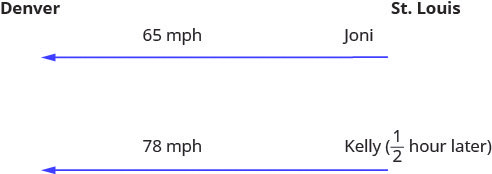
Step 1: Identify and name what we are looking for.
A chart will help us organize the data. We know the rates of both Joni and Kelly, and so we enter them in the chart.
We are looking for the length of time Kelly, [latex]k[/latex], and Joni, [latex]j[/latex], will each drive. Since [latex]D=r\cdot t[/latex] we can fill in the Distance column.
| Type | Rate x Time = Distance | ||
|---|---|---|---|
| Joni | 65 | j | 65j |
| Kelly | 78 | k | 78k |
Step 2: Translate into a system of equations.
To make the system of equations, we must recognize that Kelly and Joni will drive the same distance. So, [latex]65j=78k[/latex].
Also, since Kelly left later, her time will be [latex]\frac{1}{2}[/latex] hour less than Joni’s time.
So, [latex]k=j-\frac{1}{2}[/latex]
Now we have the system.
[latex]\left\{\begin{array}{l}k=j-\frac12\\65j=78k\end{array}\right.[/latex]
Step 3: Solve the system of equations by substitution.
[latex]65j=78k[/latex]
Substitute [latex]k=j-\frac{1}{2}[/latex] into the second equation, then solve for [latex]j[/latex].
[latex]\begin{eqnarray*}65j&=&78(j-\frac12)\\65j&=&78j-39\\-13j&=&-39\\{\color{red}{j}}&=&{\color{red}{3}}\end{eqnarray*}[/latex]
To find Kelly’s time, substitute [latex]j=3[/latex] into the first equation, then solve for [latex]k[/latex].
[latex]\begin{eqnarray*}\text{Solve for k.}\;k&=&{\color{red}{j}}-\frac12\\k&=&{\color{red}{3}}-\frac12\\k&=&\frac52\;or\;k&=&2\frac12\end{eqnarray*}[/latex]
Step 4: Check the answer in the problem.
Joni [latex]3[/latex] hours ([latex]65[/latex]mph) = [latex]195[/latex] miles.
Kelly [latex]2\frac{1}{2}[/latex] hours ([latex]78[/latex] mph) = [latex]195[/latex] miles.
Yes, they will have travelled the same distance when they meet.
Step 5: Answer the question.
Kelly will catch up to Joni in [latex]2\frac{1}{2}[/latex] hours. By then, Joni will have travelled [latex]3[/latex] hours.
Try It
18) Translate to a system of equations and then solve: Mitchell left Detroit on the interstate driving south towards Orlando at a speed of [latex]60[/latex] miles per hour. Clark left Detroit [latex]1[/latex] hour later travelling at a speed of [latex]75[/latex] miles per hour, following the same route as Mitchell. How long will it take Clark to catch Mitchell?
Solution
It will take Clark [latex]4[/latex] hours to catch Mitchell.
19) Translate to a system of equations and then solve: Charlie left his mother’s house travelling at an average speed of [latex]36[/latex] miles per hour. His sister Sally left [latex]15[/latex] minutes ([latex]\frac{1}{4}[/latex] hour) later travelling the same route at an average speed of [latex]42[/latex] miles per hour. How long before Sally catches up to Charlie?
Solution
It will take Sally [latex]1\frac{1}{2}[/latex] hours to catch up to Charlie.
Many real-world applications of uniform motion arise because of the effects of currents—of water or air—on the actual speed of a vehicle. Cross-country airplane flights in the United States generally take longer going west than going east because of the prevailing wind currents.
Let’s take a look at a boat travelling on a river. Depending on which way the boat is going, the current of the water is either slowing it down or speeding it up.
Figures 4.4.1 and 4.4.2 show how a river current affects the speed at which a boat is actually travelling. We’ll call the speed of the boat in still water [latex]b[/latex] and the speed of the river current [latex]c[/latex].
In Figure 4.4.1 boat is going downstream, in the same direction as the river current. The current helps push the boat, so the boat’s actual speed is faster than its speed in still water. The actual speed at which the boat is moving is [latex]b+c[/latex].
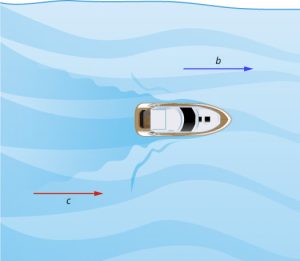
In Figure 4.4.2 the boat is going upstream, opposite to the river current. The current is going against the boat, so the boat’s actual speed is slower than its speed in still water. The actual speed of the boat is [latex]b-c[/latex].
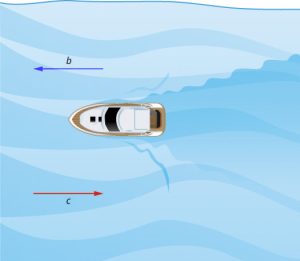
We’ll put some numbers to this situation in Example 4.4.9
Example 4.4.9
Translate to a system of equations and then solve:
A river cruise ship sailed [latex]60[/latex] miles downstream for [latex]4[/latex] hours and then took [latex]5[/latex] hours sailing upstream to return to the dock. Find the speed of the ship in still water and the speed of the river current.
Solution
Read the problem.
This is a uniform motion problem and a picture will help us visualize the situation.
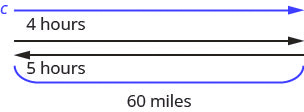
Step 1: Identify what we are looking for.
We are looking for the speed of the ship in still water and the speed of the current.
Step 2: Name what we are looking for.
Let [latex]s=[/latex] the rate of the ship in still water.
Let [latex]c=[/latex] the rate of the current
A chart will help us organize the information. The ship goes downstream and then upstream. Going downstream, the current helps the ship; therefore, the ship’s actual rate is [latex]s+c[/latex]. Going upstream, the current slows the ship; therefore, the actual rate is [latex]s−c[/latex].
| Type | Rate x Time = Distance | ||
|---|---|---|---|
| Downstream | [latex]s+c[/latex] | 4 | 60 |
| Upstream | [latex]s-c[/latex] | 5 | 60 |
Downstream it takes [latex]4[/latex] hours. Upstream it takes [latex]5[/latex] hours. Each way the distance is [latex]60[/latex] miles.
Step 3: Translate into a system of equations.
Since rate times time is distance, we can write the system of equations.
[latex]\left\{\begin{array}{l}4(s+c)=60\\5(s-c)=60\end{array}\right.[/latex]
Step 4: Solve the system of equations.
Distribute to put both equations in standard form, then solve by elimination.
[latex]\left\{\begin{array}{l}4s+4c=60\\5s-5c=60\end{array}\right.[/latex]
Multiply the top equation by [latex]5[/latex] and the bottom equation by [latex]4[/latex]. Add the equations, then solve for [latex]s[/latex].
[latex]\begin{array}{r}\left\{\begin{array}{l}20s+20c=300\\20s-20c=240\end{array}\right.\\\hline40s=540\end{array}[/latex]
Substitute [latex]s=13.5[/latex] into one of the original equations.
[latex]\begin{eqnarray*}\text{Substitute s=13.5.}\;\;\;\;\;4({\color{red}{s}}+c)&=&60\\4({\color{red}{13}}{\color{red}{.}}{\color{red}{5}}+c)&=&60\\\text{Solve for c.}\;\;\;\;\;54+4c&=&60\\4c&=&6\\c&=&1.5\end{eqnarray*}[/latex]
Step 5: Check the answer in the problem.
The downstream rate would be [latex]13.5 + 1.5 = 15\;mph[/latex].
In 4 hours the ship would travel [latex]15\cdot 4 = 60\;miles[/latex].
The upstream rate would be [latex]13.5 − 1.5 = 12\;mph[/latex].
In 5 hours the ship would travel [latex]12 \cdot 5 = 60\;miles[/latex].
Step 6: Answer the question.
The rate of the ship is [latex]13.5[/latex] mph and the rate of the current is [latex]1.5[/latex] mph.
Try It
20) Translate to a system of equations and then solve: A Mississippi river boat cruise sailed [latex]120[/latex] miles upstream for [latex]12[/latex] hours and then took [latex]10[/latex] hours to return to the dock. Find the speed of the river boat in still water and the speed of the river current.
Solution
The rate of the boat is [latex]11[/latex] mph and the rate of the current is [latex]1[/latex] mph.
21) Translate to a system of equations and then solve: Jason paddled his canoe [latex]24[/latex] miles upstream for [latex]4[/latex] hours. It took him [latex]3[/latex] hours to paddle back. Find the speed of the canoe in still water and the speed of the river current.
Solution
The speed of the canoe is [latex]7[/latex] mph and the speed of the current is [latex]1[/latex] mph.
Wind currents affect airplane speeds in the same way as water currents affect boat speeds. We’ll see this in Example 4.4.10. A wind current in the same direction as the plane is flying is called a tailwind. A wind current blowing against the direction of the plane is called a headwind.
Example 4.4.10
Translate to a system of equations and then solve:
A private jet can fly [latex]1095[/latex] miles in three hours with a tailwind but only [latex]987[/latex] miles in three hours into a headwind. Find the speed of the jet in still air and the speed of the wind.
Solution
Read the problem.
This is a uniform motion problem and a picture will help us visualize.
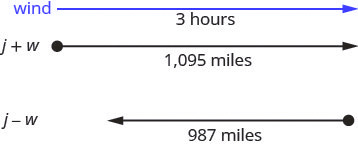
Step 1: Identify what we are looking for.
We are looking for the speed of the jet in still air and the speed of the wind.
Step 2: Name what we are looking for.
Let [latex]j=[/latex] the speed of the jet in still air.
Let [latex]w=[/latex] the speed of the wind
A chart will help us organize the information. The jet makes two trips-one in a tailwind and one in a headwind. In a tailwind, the wind helps the jet and so the rate is [latex]j+w[/latex]. In a headwind, the wind slows the jet and so the rate is [latex]j−w[/latex].
| Type | Rate x Time = Distance | ||
|---|---|---|---|
| Tailwind | [latex]j+w[/latex] | 3 | 1095 |
| Headwind | [latex]j-w[/latex] | 3 | 987 |
Each trip takes [latex]3[/latex] hours. In a tailwind the jet flies [latex]1095[/latex] miles. In a headwind the jet flies [latex]987[/latex] miles.
Step 3: Translate into a system of equations.
Since rate times time is distance, we get the system of equations.
[latex]\left\{\begin{array}{l}3(j+w)=1095\\3(j-w)=987\end{array}\right.[/latex]
Step 4: Solve the system of equations.
Distribute, then solve by elimination.
[latex]\begin{array}{r}\left\{\begin{array}{l}3j+3w=1095\\3j-3w=987\end{array}\right.\\\hline6j=2082\end{array}[/latex]
Add, and solve for [latex]j[/latex].
Substitute [latex]j=347[/latex] into one of the original equations, then solve for [latex]w[/latex].
[latex]\begin{eqnarray*}\text{Substitute j=347.}\;\;\;\;\;3({\color{red}{j}}+w)&=&1095\\3({\color{red}{347}}+w)&=&1095\\\text{Solve for w.}\;\;\;\;\;1041+3w&=&1095\\3w&=&54\\w&=&18\end{eqnarray*}[/latex]
Step 5: Check the answer in the problem.
With the tailwind, the actual rate of the jet would be [latex]347 + 18 = 365\;mph.[/latex]
In 3 hours the jet would travel [latex]365\times3 = 1095\;miles.[/latex]
Going into the headwind, the jet’s actual rate would be [latex]347 − 18 = 329\;mph.[/latex]
In 3 hours the jet would travel [latex]329\times3 = 987\;miles.[/latex]
Step 6: Answer the question.
The rate of the jet is [latex]347[/latex] mph and the rate of the wind is [latex]18\;mph.[/latex]
Try It
22) Translate to a system of equations and then solve: A small jet can fly [latex]1,325[/latex] miles in [latex]5[/latex] hours with a tailwind but only [latex]1025[/latex] miles in [latex]5[/latex] hours into a headwind. Find the speed of the jet in still air and the speed of the wind.
Solution
The speed of the jet is [latex]235[/latex] mph and the speed of the wind is [latex]30[/latex] mph.
23) Translate to a system of equations and then solve: A commercial jet can fly [latex]1728[/latex] miles in [latex]4[/latex] hours with a tailwind but only [latex]1536[/latex] miles in [latex]4[/latex] hours into a headwind. Find the speed of the jet in still air and the speed of the wind.
Solution
The speed of the jet is [latex]408[/latex] mph and the speed of the wind is [latex]24[/latex] mph.
Self Check
After completing the exercises, use this checklist to evaluate your mastery of the objectives of this section.
What does this checklist tell you about your mastery of this section? What steps will you take to improve?
Glossary
- complementary angles
- Two angles are complementary if the sum of the measures of their angles is 90 degrees.
- supplementary angles
- Two angles are supplementary if the sum of the measures of their angles is 180 degrees.
Two angles are complementary if the sum of the measures of their angles is 90 degrees.
Two angles are supplementary if the sum of the measures of their angles is 180 degrees.





